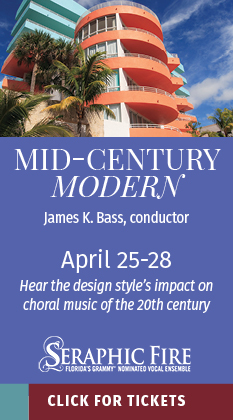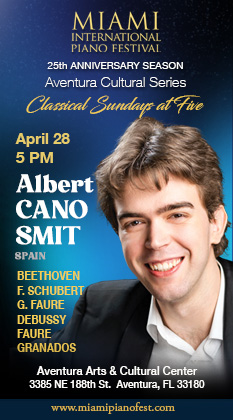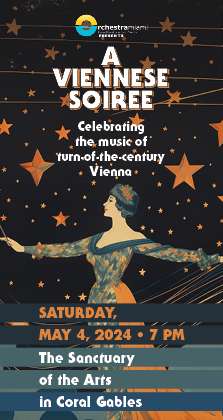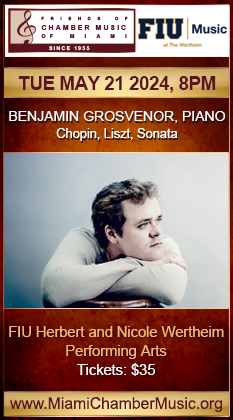De Leeuw, New World serve up powerful experience with Messiaen’s epic “Turangalîla”
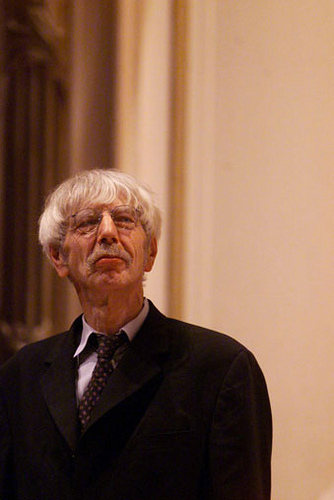
Conductor Reinbert de Leeuw led the New World Symphony in Messiaen's epic "Turangalîla-Symphonie" Saturday night.
Pounding, throbbing music, as loud as any South Beach club and infinitely more colorful, shook the hall as the New World Symphony roared through Olivier Messiaen’s monumental Turangalîla-Symphonie Saturday night. Led by Dutch conductor Reinbert de Leeuw, the 100 musicians bombarded the packed house with a wall of sound and color for 90 minutes in this Sounds of the Times program.
Messiaen’s Turangalîla-Symphonie from 1946-48 embodies joy, time, movement, rhythm, life and death in ten cyclic movements, but it is also a massive, uninhibited love song for Messiaen’s second wife, pianist and ondes martenot performer Yvonne Loriod. A precursor to the synthesizer, the ondes martenot is played by a keyboard that produces a very pure glissando (think of the Beach Boys’ Good Vibrations).
Rail thin, with a shock of white hair, de Leeuw resembles a veteran rock star, which in fact he is, in contemporary music circles. A regular conductor of the Royal Concertgebouw Orchestra, founder of the ASKO/Schönberg new music ensemble, and director of the Tanglewood Contemporary Music Festival from 1994 to 1998, de Leeuw has introduced many of the major works of the late 20th century through today.
His authoritative, commanding style is attentive to every section, soloist, and nuance of the score. Demanding to the point of fatigue for both conductor and orchestra, Turangalîla can easily end up an enormous mess. Without sacrificing the work’s exuberant, mystical qualities, de Leeuw imbued every layer of the work with clarity and intelligence, and a vigorous vitality, which the musicians returned exponentially.
Soloists Valérie Hartmann-Claverie on ondes martenot and Igor Roma on piano were mesmerizing as the central figures in the symbolic love song. A student of Loriod’s, Hartmann-Claverie’s performance exuded confidence and musicality, strikingly lyrical but occasionally stabbingly loud.
Roma’s powerful, aggressive style was on excellent display in the solo passages of “Chant d’amour II,” and “Turangalîla II.” Roma also provided the hard edge to Messiaen’s super-charged keyboard sound, with Marnie Hauschildt on celesta, Jay Ganser and Chris Riggs on glockenspiel, and Erick Wood on vibraphone, in one of the great ensemble moments of the evening.
Another was the richly brilliant brass playing in the somber opening theme of the work. Despite its complexity, Turangalîla is a cyclic work, revisiting three themes throughout. It must be great fun for the brass to be allowed to play as loudly as possible. Nor did they get much rest throughout the evening, but their stamina and tone never flagged, consistently delighting.
Clarinetists David Lemelin and Brad Whitfield were equally top notch with the extremely quiet, exposed second theme, especially in the “Développement de l’amour” where intense orchestral crescendi and sweeping keyboard solos constantly return to the quiet duo, only to build again.
Hartmann-Claverie hypnotically spun out the third theme in the hushed timelessness of “Jardin du sommeil d’amour,” with the gentlest support in strings, bird calls in the piano, and countermelodies in flute and clarinet, expertly handled by Matthew Roitstein and Brad Whitfield. Equally captivating were the exotic percussion polyrhythms of the “Turangalîla” movements, especially the third.
But the most exhilarating moments of the evening were undeniably the huge orchestral tuttis in the central movement, “Joie de sang des étoiles” and the cataclysmic, hall-shaking “Finale,” which left ears ringing and the audience on their feet.
Posted in Performances
Leave a Comment
Sun Mar 18, 2012
at 11:58 am
No Comments
